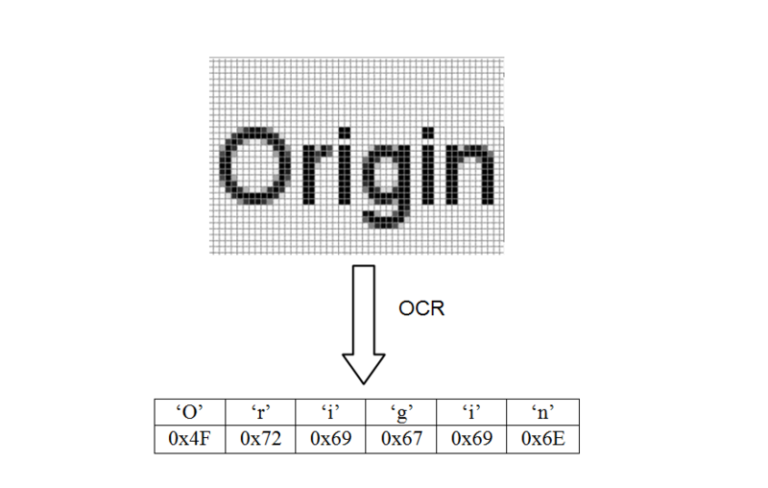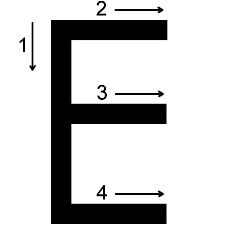Optical Character Recognition – What, How, Why.
Optical Character Recognition or OCR is the core functionality of Open Bee Portal or any document management system, for that matter. It is the technology used to identify printed text characters from a digital document or an image file. Why is this important? OCR allows you to transform these characters into code. This finds applications in multiple places, like removing manual data entry, data processing, converting text-to-speech for visually impaired people etc.
How does Optical Character Recognition work?

When OCR technology is applied on a digital document, the bitmap generated gets screened for light and dark areas. This screening allows the technology to recognise light areas as the background and the dark areas as the characters.
Once this separation is complete, the dark areas are identified as alphabets and numbers. Most OCR solutions work using the following two methodologies:
- Pattern Recognition: The software recognises the patterns formed by the bitmaps and matches it with its character database. The database would already contain letters from various fonts and formats, most of which would be computer-generated.
- Feature identification: The software would associate the features understood from the bitmaps to the database where pre-defined relations are present. The pre-defined features typically include crossed or angled lines, curves et cetera.

As an example, the alphabet “E” could be identified as three equally spaced horizontal lines perpendicular to the right side of a larger vertical line.
Post-identification, the characters are converted to code by associating it with the matching ASCII value. From here, the computer is now able to recognise the character and further act upon it.
How does Optical Character Recognition help in business operation?
For starters, it eliminates the need for manual entry into a log or system. With OCR technology, the computer is fed information directly from the digital document or the scanner. The only point of human intervention is when verification is necessary.
Recent developments in AI also show promise in identifying non-uniform handwritten messages. This is a field of promise because the possibilities are endless once you’re able to correctly identify text of any handwriting.
Some of the benefits of using OCR technology for your day-to-day business processes include:
- Higher Productivity
Because information can now be retrieved faster, employees can be more productive at work. With digital documents, employees save nearly 4 hours every day by not searching for physical documents.
- Cost Reduction
OCR technology Opting for OCR will help businesses on cutting down on hiring professionals to carry out data extraction, which is one of the most important benefits of OCR data entry methods. This tool also helps in trimming various other costs, such as copying, printing, shipping, etc. Therefore, OCR eliminates the cost of misplaced or lost documents and offers higher savings in the form of reclaimed office space, which would otherwise be used for storing paper documents.
- High Accuracy
One of the major challenges of data entry is inaccuracy. Automated data entry tools such as OCR data entry result in reduced errors and inaccuracies, resulting in efficient data entry. Besides, problems like data loss can also be successfully tackled by OCR data entry. As there is no manpower involved, the issues such as keying in wrong information accidentally or otherwise can be eliminated. - Increased Storage Space
OCR can scan, document, and catalogue information from enterprise-wide paper documents. This simply means that the data can now be stored in an electronic format in servers, eradicating the need for maintaining huge paper files. In this way, OCR data entry serves as one of the best tools to implement “Paperless” approach across the organization. - Superior Data Security
Data security is of utmost importance for any organization. Paper documents are easily prone to loss or destruction. Papers can be misplaced, stolen, or destroyed by natural elements such as moisture, pests, and fire. However, this is not the case with data that is scanned, analyzed, and stored in digital formats. Furthermore, the access to these digital documents can also be minimized to prevent mishandling of the digitized data. - 100% Text-searchable Documents
One of the huge advantages of OCR data processing is that it makes the digitized documents completely text searchable. This helps professionals to quickly lookup numbers, addresses, names, and various other parameters that differentiate the document being searched. - Massively Improves Customer Service
Several inbound contact centers often provide information that their customers seek. While some call centers provide customers with the information they need, the others will have to quickly access certain personal or order-related information of the customers to process their requests. Quick data accessibility becomes extremely important in such cases. OCR helps in systematically storing and retrieving the documents digitally at blazing speeds. With this, the waiting time is drastically reduced for the customers, thereby improving their experience. - Makes Documents Editable
Scanned documents need to be edited most of the time, particularly when some information must be updated. OCR converts data to any preferred formats such as Word, etc., which can be easily edited. This can be of great help when there are contents which have to be constantly updated or regularly changed. - Disaster Recovery
Disaster recovery is one of the major benefits of using OCR for data entry. When data is stored electronically in secure servers and distributed systems, it remains safe even under emergency situations. When there are sudden fire breakouts or natural calamity, the digitized data can be quickly retrieved to ensure business continuation.
Who Can Leverage OCR?
Any firms and enterprises planning to do away with paper documents can leverage OCR data entry. OCR can also be used to transfer important documents to tablets, computers, smartphones, etc. Right from businesses in banking, mortgage, and financial sectors to those in legal, payroll, and healthcare sectors anyone can leverage this tool. Outsourcing OCR based data entry services to a reliable partner can help you save huge costs and valuable time. Some documents which are extensively being digitized include, but not limited to –
- Invoices
- Industry articles
- Tax documents
- Payroll information
- Legal filings
- Contact information
- Business cards and fliers
- Financial investments
Optical Character Recognition Use Cases
OCR can be used for a variety of applications, including:
- Scanning printed documents into versions that can be edited with word processors, like Microsoft Word or Google Docs.
- Indexing print material for search engines.
- Automating data entry, extraction and processing.
- Deciphering documents into text that can be read aloud to visually-impaired or blind users.
- Archiving historic information, such as newspapers, magazines or phonebooks, into searchable formats.
- Electronically depositing checks without the need for a bank teller.
- Placing important, signed legal documents into an electronic database.
- Recognizing text, such as license plates, with a camera or software.
- Sorting letters for mail delivery.
- Translating words within an image into a specified language.
Benefits of Optical Character Recognition
The main advantages of OCR technology are saved time, decreased errors and minimized effort. It also enables actions that are not capable with physical copies such as compressing into ZIP files, highlighting keywords, incorporating into a website and attaching to an email.
While taking images of documents enables them to be digitally archived, OCR provides the added functionality of being able to edit and search those documents.
The video below summarizes the arguments made in a quick 2-minute video.
